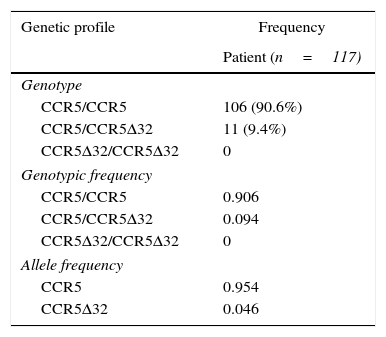The expression of CCR5 gene, located on the short arm of chromosome three (3p21.31), leads to the formation of a protein that acts as a receptor for several chemokines.1 A deletion of 32 base pairs gives rise to an important Rs333 polymorphism. The heterozygous genotype CCR5/Δ32 produces partially functional receptors while the homozygous recessive Δ32/Δ32 features a non-functional receptor.2
Information about the prevalence of Rs333 is an essential aspect of medical decisions, mainly for CCR5 blockers prescription to HIV patients. Furthermore, immunogenetics studies that include the prevalence of CCR5 genes or other genetic factors in the population of Roraima State, Brazil, were not found in the literature.
To determine the prevalence of Rs333 polymorphism located in the CCR5 gene, we designed a cross-sectional study with HIV-infected patients living in Roraima, who had blood sent for analyses at the Central Laboratory of Roraima State (LACEN/RR). The Ethics Research Committee (REC) from the Federal University of Roraima (COEP/UFRR) approved this research (CAAE number: 15629013.8.0000.5302). Subsequently, 5mL of blood samples were collected from 120 HIV-1 infected patients between January 2014 and February 2014. Genomic DNA was extracted using the automated system QIAcube, with QIAamp DNABlood Kit (QIAGEN, Germany) followed by PCR amplification as described previously3 and agarose gel electrophoresis. Three of these samples were rejected. Thus, our sampling represents more than 10% of all HIV-infected patients, including patients from 12 out of 14 municipalities in the Roraima state.
Two genotypes were found in this group of patients: 106 patients had CCR5/CCR5 represented by a single fragment of 137bp, and 11 patients had CCR5/CCR5Δ32 characterized by two fragments, one of 137bp and another of 105pb. Nevertheless, the CCR5Δ32/CCR5Δ32 genotype was not found in this study (Table 1).
Occurrence of genotypes, genotype frequency and allele frequency of the CCR5 gene in Roraima, Brazil.
| Genetic profile | Frequency |
|---|---|
| Patient (n=117) | |
| Genotype | |
| CCR5/CCR5 | 106 (90.6%) |
| CCR5/CCR5Δ32 | 11 (9.4%) |
| CCR5Δ32/CCR5Δ32 | 0 |
| Genotypic frequency | |
| CCR5/CCR5 | 0.906 |
| CCR5/CCR5Δ32 | 0.094 |
| CCR5Δ32/CCR5Δ32 | 0 |
| Allele frequency | |
| CCR5 | 0.954 |
| CCR5Δ32 | 0.046 |
Roraima is one of the newest states of the Brazilian Federation and one of the principal mining centers in the country during the 80s and 90s, which attracted Brazilians from other regions contributing to the population miscegenation.4 The Δ32 allele has its origin in Europe; in Brazil it has different frequencies varying from 4.2% in the North region, to 6.4% in the South and 0.2% in Native americans.5 That frequency in the North region, where Roraima is located, is similar to what was found in this study (4.6%).
Due to the undoubted protective effect of CCR5Δ32 against HIV infection and aids progress, that project was not designed as an inference study to evaluate this marker as an immunogenic protective factor in Roraima's HIV-infected patients. Thus, healthy controls were not included. Yet, to our knowledge, this is the first study about the prevalence of immunogenetic factors in HIV-infected patients from Roraima State.
Conflicts of interestThe authors declare no conflicts of interest.
This work was supported by Instituto Lêonidas e Maria Deane/FIOCRUZ – AM and LACEN-RR.





